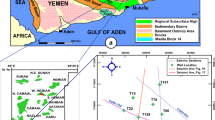Abstract
The Lower Cretaceous Qishn Formation at Masila Basin, Yemen, contains substantial amounts of proven crude oil. It is divided into a lower shaly silisiclastic member and an upper carbonate member. In the present work, detailed formation evaluation of the Upper Qishn Clastic Member was carried out using the digitized well logging data from 12 wells, via computer-assisted analysis, to accomplish its reservoir characteristics and oil potentiality. Accordingly, the true resistivity (R t), porosity (total φ t and effective φ e), shale content (V sh), permeability (K), water saturation (S w), hydrocarbon saturation (S h) (movable “S hm” and residual “S hr”) and lithologic composition in each well were estimated, analyzed, and illustrated versus depth on litho-saturation cross-plots. Likewise, the areal distribution of such parameters alongside the member in the investigated area and their relations to geological setting were defined from the constructed isoparametric contour maps. Based on the obtained results, the components of Upper Qishn Clastic Member of Masila Basin are mainly shaly sandstone and minor calcareous sandstone with considerable amount of shale. Regionally, the Member was deposited on an inner neritic to shallow-marine platform setting. It is interpreted as a good-quality reservoir rock which has been established from high total porosity (15–22 %), good effective porosity (8–13 %), and variable shale volume (24–31 %). A number of high hydrocarbon saturation zones (exceeding 55 %) are detected through intervals having S w < 60 % and S hm > 20 % which have been considered as economic oil producers. The storage and pay capacities of the reservoir intervals have been resolved. The obtained results were confirmed from the available data of core analyses and production tests. The Upper Qishn Clastic Member reveals promising reservoir characteristics which should be taken into consideration during future development of the oilfields in the area.















Similar content being viewed by others
References
Allen LS, Mills WR, Goldwell RI (1965) The effect of fluid invasion in pulsed neutron logging. Geophysics 30(3):389-395
Archie GE (1942) The electrical resistivity logs as an aid in determining some reservoir characteristics. Trans AIME 146:45–62
Beydoun ZR, Bamahmoud MO, Nani SO (1993) The Qishn Formation, Yemen, lithofacies and hydrocarbon habitat. Mar Pet Geol 10:364–372
Beydoun ZR, Al-Saruri MI, Baraba RS (1996) Sedimentary basins of the Republic of Yemen: their structural evolution and geological characteristics. Rev Inst Fr Petrol 51:763–775
Beydoun ZR, Al-Sururi M, El–Nakhal H, Al-Ganad I, Baraba R, Nani AO and Al- Aowah M, (1998) Internal lexicon of stratigraphy v.III, ASTA
Clavier C, Hoyle WR, Meunier D, (1971) Quantitative interpretation of TDT logs: parts I and II, J Pet. Tech. 743–763
Doveton JH (1986) Log analysis of subsurface geology—concepts and computer methods. John Wiley & Sons, New York, 273 p
Dresser Atlas (1979) Log interpretation charts. Dresser Industries, Inc, Houston, 107 p
Dresser Atlas (1982) Well logging and interpretation techniques, the course for home study. Dresser Industries Inc, Houston
Ellis AC, Kerr HM, Cornwell CP, Williams DO (1996) A tectonostratigraphic from work for Yemen and its implication for hydrocarbon potential. Pet Geosci 2:29–42
Golonka J, Ross MI, Scotese CR (1994) Phanerozoic paleogeographic and paleoclimatic modeling maps. In: Embry AF, Beacuchamp B, and Glass DJ (eds.) Pangea: global environments and resource: Canadian Society of Petroleum Geologists Memoir 17, 1–48
Hilchie DW (1982) Advanced well log interpretation. Douglas W. Hilchie, Inc, Golden Colorado, 347p
King WA, Mills B, Gardiner S, Abdillah AA (2003) The Masila fields, Republic of Yemen. In: M.T. Halbouty (ed) Giant oil and gas fields of the decade 1990–1999. AAPG Memoir 78:275-295
Křestĕn J, Kalina J (1979) Automatizované zpracování karotážních mĕřeni N-vrtu projektu Qattara (Egypt): Zemni Plyn a Nafta, Hodonin, v. 24, n. 3, 453–479
Leckie DA, Rumpel T (2003) Tide influenced sedimentation in a rift basin—Cretaceous Qishn Formation, Masila block, Yemen: a billion barrel oil field. AAPG Bulletien 87(6):987–1013
Mills SJ (1992) Oil discoveries in the Hadramaut: how Canadianoxy scored in Yemen. Oil Gas J 9:49–52
Omran AA (1995) Computer formation evaluation using well-logging data in Shukeir area, Gulf of Suez, Egypt. Bull Fac Sci Assiut Univ 24(1-F):41–66
Redfern P, Jones JA (1995) The interior basins of Yemen—analysis of basin structure and stratigraphy in a regional plate tectonic context. Basin Res 7:337–356
Schlumberger (1972a) Log interpretation: v. 1 (principles). Schlumberger Limited, New York, 113 p
Schlumberger (1972b) The essential of log interpretation practice. Schlumberger, France
Schlumberger (1974) Log interpretation: v. 2 (application). Schlumberger Limited, New York, 116 p
Schlumberger (1984) Well evaluation conference of Egypt. Schlumberger, Middle East, 201 p
Schlumberger (1989) Log interpretation charts. Schlumberger Ltd., 74-105
Simandoux P (1963) Measures dielectrique en milieu poreux, application a mesure de saturation en eau, etude des massifs argileaux, Revue de l’ Inst. Francais du petrole, supplement Issue, 193–215
Wyllie MRJ (1963) The fundamentals of well log interpretation. Academic Press, New York
Wyllie MRJ, Gregory AR, Gardner GHF (1958) An experimental investigation of factors affecting elastic wave velocities in porous media. Geophysics 23(3)
Acknowledgment
The authors wish to express deep thanks to the Yemen Petroleum Exploration and Production Authority (PEPA) for providing the data used in this work.
Author information
Authors and Affiliations
Corresponding author
Rights and permissions
About this article
Cite this article
Omran, A.A., Alareeq, N.M. Log-derived petrophysical characteristics and oil potentiality of the Upper Qishn Clastic Member, Masila Basin, Yemen. Arab J Geosci 7, 1733–1748 (2014). https://doi.org/10.1007/s12517-013-0871-z
Received:
Accepted:
Published:
Issue Date:
DOI: https://doi.org/10.1007/s12517-013-0871-z




